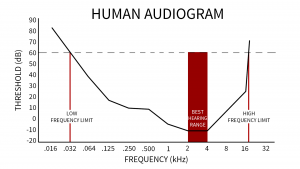In my latest “How to Make Music” video, I tackle the distinction between mp3 vs wav audio files. The science behind how an mp3 is made–you actually get to hear exactly what sound gets removed to make an mp3 so small–and when NOT to use one. We’ll also go over ISRC, the International Standard Recording Code, which every musician needs to track sound recordings for royalties. Finally, I talk about digital distribution, how to get you music on iTunes, and I also share a VIP discount link for Distrokid. Check it out!
Most people know mp3s aren’t full quality audio files. They’re a handy compromise between small file size and acceptable sound quality. A typical mp3 is about a tenth of the size of an uncompressed CD quality audio file. How mp3’s achieve this feat is a pretty neat bit of science. Mp3 encoders use a psychoacoustic model; a model of our perception of how things sound. The idea is to discard the parts of the sound which are less noticeable to human hearing.

mp3 vs wav. mp3 encoders use a psychoacoustic model which is a model of how humans perceive sound
Listen to the video to hear an example of what gets lost during the encoding an mp3–it’s a fascinating (and somewhat haunting) sound!
But when listening to the resultant mp3, most people won’t notice there’s anything missing. And that’s why mp3s are so popular: the filesize is small and what you lose, often enough, is not so bad. But if you’re going to sell your music on iTunes, or stream on Spotify, or distribute your music to any of the stores or services out there, don’t send them an mp3.
See, not all the stores use the same format. iTunes uses .aac (Advanced Audio Coding), Spotify uses .ogg (Ogg Vorbis) and you don’t want to send something that’s already been stripped of extraneous information to have another process done upon it. That’s making a photocopy of a photocopy! You want to send them the lossless, uncompressed source audio file; that’s your wav file.
So when should you use an mp3 file? Well, you can choose to use one anytime you’re sharing your music direct to listeners; they’re probably not going to encode your music again so you avoid the photocopy of a photocopy effect and your listeners will probably be happy you’re not taking up all of their storage space. But consider using .ogg–in many circumstances, Ogg Vorbis produces files that are as small as an .mp3 but retain better sound quality. You might also look into encoding to .flac which is identical in quality to .wav but achieves a smaller filesize. Pretty cool.
For more on mp3 vs wav files…
As well as ISRC, how to get your music on iTunes, Spotify and digital distribution in general, check out my video!
